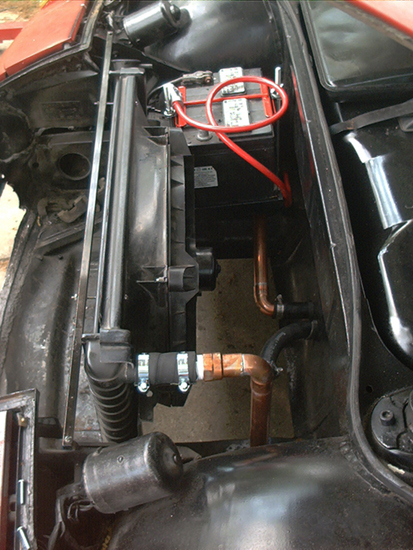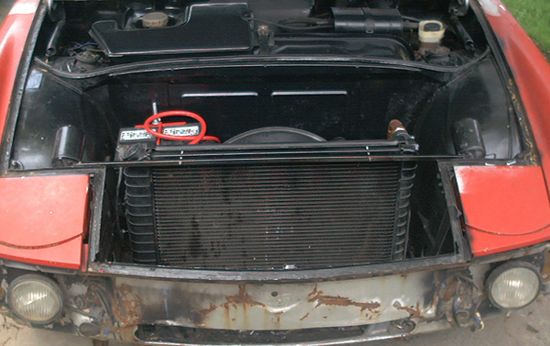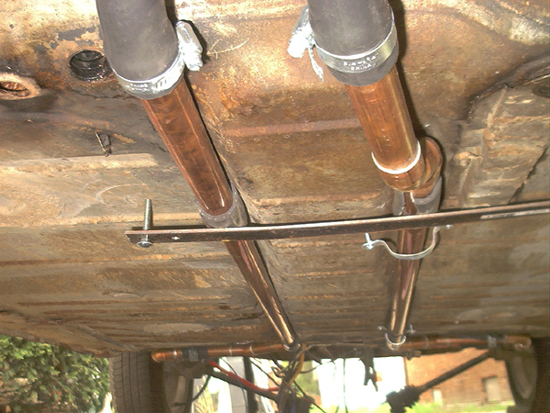|
|

|
Porsche, and the Porsche crest are registered trademarks of Dr. Ing. h.c. F. Porsche AG.
This site is not affiliated with Porsche in any way. Its only purpose is to provide an online forum for car enthusiasts. All other trademarks are property of their respective owners. |
|
|
  |
| 914GT |
 Feb 2 2005, 08:00 PM Feb 2 2005, 08:00 PM
Post
#41
|
||
|
Senior Member    Group: Members Posts: 1,101 Joined: 11-October 04 From: Tucson Member No.: 2,923 Region Association: Southwest Region |
Still is! Just moved the main heat transfer up to the front of the car (IMG:http://www.914world.com/bbs2/html/emoticons/smile.gif) |
||
| marks914 |
 Feb 2 2005, 08:14 PM Feb 2 2005, 08:14 PM
Post
#42
|
|
Senior Member    Group: Members Posts: 845 Joined: 9-October 04 From: the motor city Member No.: 2,912 Region Association: None |
Here are some pics of my setup during the build. Here is how I built my system for under $200 (excluding pump).
84-89 corvette stock radiator, fan and shroud $125 (Used) JC Whitney thermo switch: $25 copper pipe and such: $30 1 inch truck heater hose and alot of clamps: $15 The corvette is a bottom breather, as are the 914 V8 cars. The airflow should be about the same. I have a 305ci engine. Should run the same temp as a 350. The vette radiator is the shortest radiator for a v8 I could find. I have put about 12000 miles on the car in a year and a half. It runs at 180 all day, even in traffic on a hot 90-100 degree day. The only time it gets over 180 is when the RPMS are sustained over 3300 for more than 15-20 minutes, then it can run 200-210. It has never exceeded 210. Now,with the money I saved from buying the Renegade radiator I had the trans regeared. With the new gearing, the revs rarely see over 3000 for more than 20 minutes. Mark Attached image(s) 
|
| marks914 |
 Feb 2 2005, 08:15 PM Feb 2 2005, 08:15 PM
Post
#43
|
|
Senior Member    Group: Members Posts: 845 Joined: 9-October 04 From: the motor city Member No.: 2,912 Region Association: None |
Here is another, I have cutout the wheelwells since this stage.
Attached image(s) 
|
| marks914 |
 Feb 2 2005, 08:17 PM Feb 2 2005, 08:17 PM
Post
#44
|
|
Senior Member    Group: Members Posts: 845 Joined: 9-October 04 From: the motor city Member No.: 2,912 Region Association: None |
Here are the hardlines under the car when I was test fitting them. Its good to have some bends so that when the pipes are attached, they do not twist. I hope this helps.
Mark Attached image(s) 
|
| scotty914 |
 Feb 2 2005, 09:06 PM Feb 2 2005, 09:06 PM
Post
#45
|
||
|
suby torque rules    Group: Members Posts: 1,528 Joined: 20-July 03 From: maryland, the land of 25 year Member No.: 924 |
simply the reason why the old radiator is 1.25 for a single row, is simple. look at it this way radiating the heat to the air is a surface area thing. the larger the fins the more heat each tube can give out. the more tubes the less the area of the fins. now in a modern radiator there are many tubes with less fin depth, but i would think that the tube surface area ( water side ) ratio to the fin surface area ( air side ) to the over all size works out to about the same for every maker, to engine size. with a modern radiator they have had years to figure the best cheapest stongest way to make the radiator. |
||
| tesserra |
 Feb 2 2005, 11:24 PM Feb 2 2005, 11:24 PM
Post
#46
|
|
Member   Group: Members Posts: 210 Joined: 26-March 03 From: Lafayette CA Member No.: 479 |
With all this talk about too much flow of coolant there is something I don't understand.
Why is a cooling system less efficient when it has a smaller delta t with a larger flow of fluid, vs higher delta t with a smaller flow. The total heat exchanged should be the same. More water at slightly different temp or less water at large temp change? I have an early renegade cooling system and they used a "lay down" set up, kinda like the early Corvettes. I have noticed that two of the corners of the rad are hotter to the touch than the other corners. It is an old radiator and I suspect less water flow in the hot spots. Any ideas? George |
| bondo |
 Feb 2 2005, 11:59 PM Feb 2 2005, 11:59 PM
Post
#47
|
|
Practicing my perpendicular parking     Group: Members Posts: 4,277 Joined: 19-April 03 From: Los Osos, CA Member No.: 587 Region Association: Central California |
Well there are two deltaTs. One is water to air, the other is engine to water. If you move a lot of water through the radiator but don't cool it as much, you may get the same amout of heat transferred to the air. But then that larger quantity of water is still pretty warm and can't take much more heat from the engine.. so the engine gets hotter and hotter until the deltaT is enough to reach a new equilibrium. If that point is above the boiling point of the coolant, you're in trouble (IMG:http://www.914world.com/bbs2/html/emoticons/smile.gif)
As far as the cooler corners of the radiator goes, it could be obstructions in the tubes, or just the way the radiator design works with the rest of the cooling system. |
  |
1 User(s) are reading this topic (1 Guests and 0 Anonymous Users)
0 Members:

|
Lo-Fi Version | Time is now: 11th July 2025 - 05:59 AM |
Invision Power Board
v9.1.4 © 2025 IPS, Inc.







